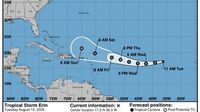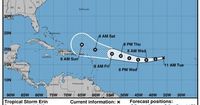Tropical Storm Erin, the fifth named storm of the 2025 Atlantic hurricane season, has quickly become the focus of meteorologists and coastal residents alike as it churns westward across the Atlantic Ocean. On August 12, 2025, the National Hurricane Center (NHC) issued an advisory stating that Erin was expected to intensify into a hurricane within 48 hours, with forecasts indicating that it could reach Category 3 strength by Sunday, August 17. As the storm’s projected path and potential impact areas become clearer, uncertainty and anticipation are mounting across the Caribbean and the U.S. East Coast.
According to USA TODAY, Erin was racing west at 22 mph, with maximum sustained winds of 45 mph and a central pressure of 1,004 mb as of August 12. The storm’s center was located roughly 690 miles west of the Cabo Verde Islands, or about 1,890 miles east of the northern Leeward Islands. While Erin’s current trajectory keeps it far from the U.S. mainland, meteorologists caution that the storm’s path could shift, and its effects may be felt on both sides of the Atlantic.
Federal forecasters, as reported by NPR, expected Erin to begin strengthening late Wednesday and likely achieve hurricane status by late Thursday. The storm’s tropical-storm-force winds already extended outward up to 35 miles from the center, and its westward march was projected to continue, with a gradual turn toward the west-northwest as it approached the Caribbean. The NHC warned that the likelihood had increased for Erin to move closer to Puerto Rico, the Virgin Islands, and the northern Leeward Islands by the weekend of August 16-17. However, it remains too early to determine the exact impacts, if any, on these islands or the U.S. mainland.
Tragically, the severe weather system associated with Erin has already claimed lives. At least eight people were killed on the Cape Verdean island of São Vicente following heavy rains and storms, according to Reuters and a statement by Cape Verdean President Jose Maria Pereira Neves. The president noted that the storms had caused both fatalities and significant property damage on the island. These early impacts underscore the destructive potential of tropical systems even before they fully organize into hurricanes.
The 2025 Atlantic hurricane season, which runs from June 1 through November 30, is now entering its most active period. According to NOAA, 97% of tropical cyclone activity occurs during these months, with the peak typically arriving in August and September. This year, NOAA has predicted an above-average season, with 13 to 19 named storms expected—driven by a combination of warmer ocean temperatures and weak wind shear. Colorado State University meteorologists are forecasting 16 named storms, including eight hurricanes and three major hurricanes, maintaining their July outlook for a slightly above-average season.
Comparing this season to last year, the difference is stark, especially for Texas. As USA TODAY reported, the 2024 season was marked by early and intense activity, including Hurricane Beryl, which became the earliest Category 5 Atlantic hurricane on record before making landfall in Texas. In contrast, the 2025 season has so far been relatively quiet for the Lone Star State, with no storms directly affecting its coastline. Nevertheless, forecasters are warning residents not to be complacent as the season’s most active stretch is just beginning.
Despite the uncertainty surrounding Erin’s path, one thing is certain: even if the storm does not make landfall in the United States, it is expected to bring increased seas, surf, and dangerous rip currents along the East Coast beaches from August 16-20. "There will be a significant increase in seas, surf and rip currents along the East Coast beaches next weekend into the following week," said AccuWeather Senior Meteorologist Chad Merrill, as cited by USA TODAY. Residents and vacationers are urged to remain vigilant and heed local advisories as conditions evolve.
Forecasting tropical cyclones remains a complex challenge, particularly beyond a seven-day window. The NHC uses a suite of high-performing models to provide the most accurate possible guidance, but as Kim Doster, director of communications for NOAA, explained to The New York Times, "While the predictability of tropical cyclones has never extended beyond a week into the future, our hurricane prediction inputs and models are the most sophisticated they have ever been, and we are confident in the N.H.C.’s capability to provide reliable, actionable data to inform and protect our communities."
The uncertainties are not just technical. The Trump administration’s reduction in staffing at agencies like NOAA, the Weather Service, and FEMA has left some experts wondering how these cuts might affect forecast accuracy and disaster response, though hiring may resume soon. These institutional shifts come at a time when the stakes for accurate forecasting and timely warnings have arguably never been higher.
Historical comparisons offer both caution and context. Hurricane Irma in 2017 and Hurricane Lee in 2023 both demonstrated the difficulty of long-range hurricane forecasting. In Irma’s case, most models predicted a track up Florida’s east coast, but the storm ultimately struck further west after tearing through the Caribbean. Lee, meanwhile, largely followed model guidance, staying offshore before weakening and making landfall in Nova Scotia. As The New York Times noted, Erin formed in a location similar to where Irma developed, and current models show a range of possible outcomes, from curving harmlessly away from land to potentially threatening the Caribbean or U.S. coast.
Underlying these forecasts are the physical drivers of hurricane formation and intensification. Warmer-than-average sea surface temperatures in the Atlantic are providing ample fuel for storms, while weak wind shear—unlike the high shear that suppressed activity earlier in the summer—now favors storm organization and strengthening. Brian McNoldy, a senior research associate at the University of Miami, explained, "Warm anomalies on top of that do make rapid intensification more likely for storms that develop." Climate change is also playing a role, with rising ocean temperatures making hurricanes more intense and increasing the risk of severe flooding, stronger winds, and heavier rainfall, as highlighted by NPR.
While Erin’s future remains uncertain, the NHC and meteorologists across the globe are watching closely. The storm’s projected path has shifted slightly south in recent updates, raising concerns for the northern Leeward Islands and prompting officials in Puerto Rico, the Virgin Islands, and neighboring territories to monitor developments closely. With the Atlantic hurricane season now entering its peak, residents from the Caribbean to the U.S. East Coast are reminded of the importance of preparedness and the unpredictable nature of these powerful storms.
As Tropical Storm Erin barrels across the Atlantic, its story is still being written. Whether it becomes a major hurricane or curves harmlessly out to sea, its formation marks the true beginning of the 2025 hurricane season’s most dangerous months—and a timely reminder of the vigilance required in the face of nature’s most formidable forces.






